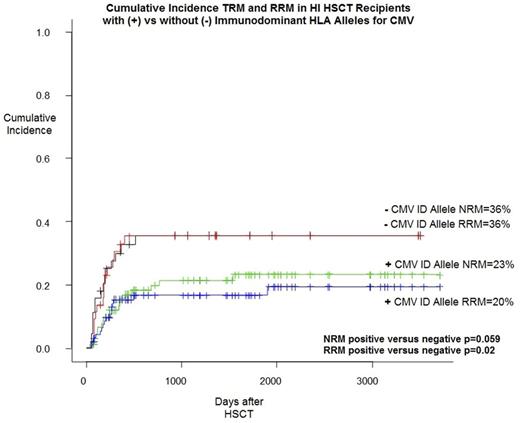Abstract
CMV reactivation is associated with increased treatment-related mortality (TRM), decreased overall survival (OS), and in some analyses, protection from relapse after HSCT. We previously showed that CMV reactivation was significantly higher in HI versus matched related HSCT recipients receiving an identical preparatory regimen, implicating HLA mismatch as a contributor to reactivation. It is known that specific CMV immunodominant HLA alleles (CMV ID alleles) are associated with more efficient antigen presentation and protection from CMV. We hypothesized that a match at a CMV ID allele in the shared haplotype of the donor and recipient pairs may overcome the disadvantage proffered by HI HSCT with respect to CMV. As a control, we tested whether the presence of a CMV ID allele in either the donor or recipient, as opposed to a match at the CMV ID allele, was the more important impactor of outcomes. This information would potentially impact donor selection and identify HI recipients with greater risk for CMV-related complications.
Methods
This is a retrospective, analysis of 138 HI HSCT recipients at risk for CMV reactivation as defined by the presence of positive CMV serologic status in the recipient, donor, or both. All recipients were treated on the Jefferson 2 step approach in which after conditioning, a fixed T cell dose (2 x 108/kg) is administered (step 1), followed 2-3 days later by cyclophosphamide (CY) for bidirectional tolerization. Two days after CY, patients receive a CD34-selected donor product (step 2). To be included in the analysis, patients had to successfully engraft and be alive for at least 1 month post HSCT. Outcomes related to CMV, 1) reactivation incidence, 2) peak copy number of initial CMV reactivation occurring by d+100, 3) TRM, 4) relapse related mortality (RRM), and 5) OS, were tested in 3 contexts: the presence vs the absence of a CMV ID allele in the recipient or the donor, or the presence or absence of a donor/recipient (R/D) match at the same CMV ID allele. CMV ID alleles were defined as HLA A01:01, A02:01, A24:02, B07:02, B08:01, B35:01 and C07:02. Statistics used: incidence of CMV reactivation=Chi-Square; comparison of peak CMV copy numbers=T-test; assessment of RRM and NRM=cumulative incidence (CI); OS=Kaplan-Meier method.
Results:
A CMV ID allele was present in 68.1% recipients and 66.7% donors. 41.7% of D/R pairs were matched at the same CMV ID allele. The incidence of CMV reactivation was not associated with a D/R CMV ID allele match or recipient or donor CMV ID allele positivity. Peak CMV levels were lower in the presence of any recipient or donor CMV ID allele, but only approached significance in D/R pairs matched at the same CMV ID allele (p=0.065) with a mean of 8.7 x 10e3 vs 4.1 x10e4 copies/ml by PCR in matched vs non-matched pairs respectively. At 3 years, in recipients who matched their donor at 1 or more CMV ID alleles vs those who had no match, CI of NRM was 28% vs 26% (p=0.48) and 16% vs 32% (p=0.07) for RRM. In recipients with vs without a CMV ID allele CI of NRM was 23% vs 36% (p=0.059) and 20% vs 36% for RRM (p= 0.02) (Figure). In recipients with donors who possessed a CMV ID allele vs not, CI of NRM was 27% vs 28% (p=0.80) and 21% vs 31% for RRM (p= 0.12). OS in recipients who were matched at the same CMV ID allele with their donors or who possessed a CMV ID allele was 51% vs 37% (p=0.062) and 52% vs 27% (p=0.001) respectively as compared to recipients negative for these alleles.
Conclusion:
This analysis suggests that matching HI D/R pairs at a CMV ID epitope may reduce CMV peak copy number but has no significant effect on post HSCT reactivation. Recipient positivity for a CMV ID allele was strongly associated with improvement in NRM, RRM, and OS. Whether the benefit is specific to improved CMV control or to a more efficient antigen presentation in general by these alleles is unknown, but should be further investigated. This data requires confirmation with multivariate analysis.
Wagner: Novartis: Research Funding.
Author notes
Asterisk with author names denotes non-ASH members.


This feature is available to Subscribers Only
Sign In or Create an Account Close Modal